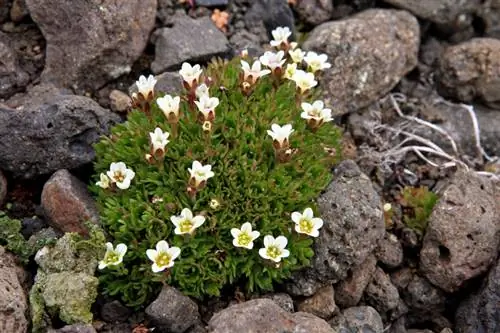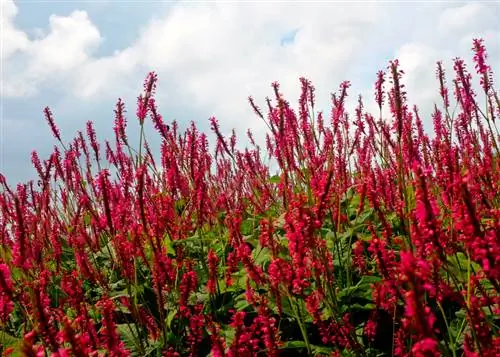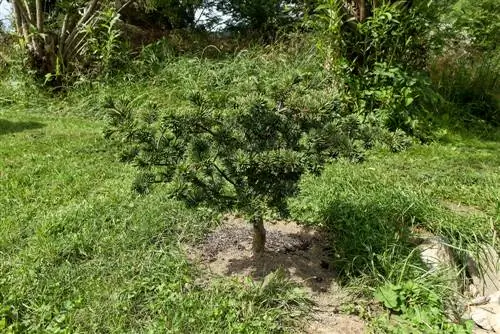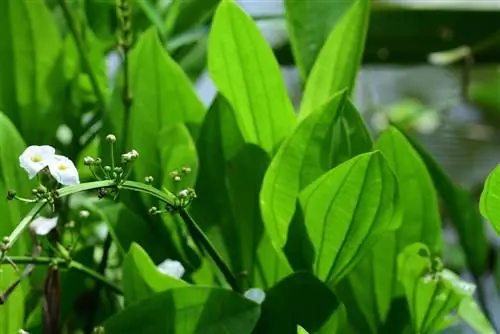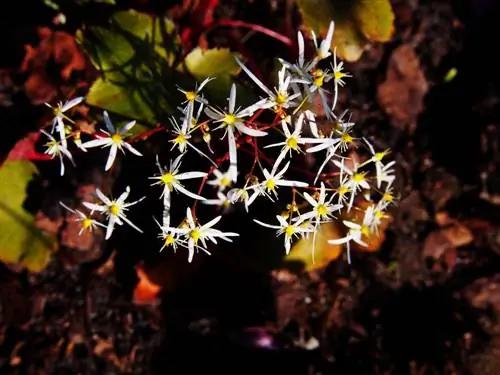- Author admin [email protected].
- Public 2023-12-25 17:45.
- Last modified 2025-01-23 11:22.
Saxifrage decorates dry stone walls, gravel beds, graves and tuff stones in spring or autumn with dense carpets of flowers. In winter, the pretty, green leaf rosettes tirelessly decorate the garden. Once you have discovered your favorites among the 450 species, they pull together when it comes to cultivation. Any questions that remain unanswered will receive a practical answer here.

How do I care for saxifrage in the garden?
Saxifrage plants prefer partially shaded locations with sandy, humus-rich, calcareous soil. They are undemanding in terms of care; they only require initial fertilization in March, moderate watering without waterlogging and pruning of withered flower stalks. Hardy, leaf protection can be helpful in the planting year.
Planting saxifrage correctly
For the heralds of spring among the Saxifraga, autumn is the planting time, while an autumn-flowering plant is preferably planted in the ground in April/May. Regardless of the season, saxifrage planting follows the following pattern:
- Dig small pits at a distance of 30 to 40 cm with 1.5 times the volume of the root ball
- If necessary, improve the excavation with sand, fine-grained chippings or compost
- Place the potted plant in the middle to fill the cavities with substrate up to the lower pair of leaves
Finally, water the Saxifraga and spread a layer of mulch. Depending on the type and variety, both organic materials, such as leaves or grass clippings, as well as inorganic chippings or gravel are suitable.read more
Care tips
If a saxifrage plant finds optimal site conditions, the care program demands little from the gardener. Starting fertilization with compost and horn shavings in March paves the way for a season full of flowers. Watering is carried out when it is dry without standing puddles of water forming. For a neat appearance, simply cut off the withered flower stalks with electric lawn shears (€49.00 on Amazon). Leave the foliage on evergreen or wintergreen Saxifraga until spring. Explicit winter protection is not necessary. Only in the year of planting does a layer of leaves protect the young flower from seasonal stress.read more
Which location is suitable?
In partially shaded locations, warm and protected, but without the blazing midday sun, Saxifraga are at their best. This can be under a canopy of thick trees, on the east or north side of the rock garden or in the sunny area of a dry stone wall. If the soil is also sandy, humic and calcareous, the plant is completely happy.read more
What soil does the plant need?
For saxifrage to meet expectations as a lushly flowering ground cover, the soil should first and foremost be loose and permeable. A fresh, moist and humus-rich structure perfectly meets the wishes of this busy flower in order to develop an abundant carpet of flowers. As a substrate in the planter, a compost-based potting soil meets the requirements, optimized with a handful of sand or lava granules.
When is flowering time?
The species-rich Saxifraga genus provides us with magnificent specimens with different flowering times. To give you an insight into the large selection, we have listed a selection of common varieties here:
- Moss saxifrage (Saxifraga arendsii ssp.): flowering period from April to May/June
- Cup saxifrage (Saxifraga cotyledon): flowering period from June to August
- Autumn saxifrage (Saxifraga cortusifolia var. fortunei): flowering period from September to November
At the end of the flowering period, the floral fireworks of a saxifrage are far from extinguished. The succulent or fine leaves in divergent colors decorate the plant continuously throughout the rest of the year.
Cut saxifrage correctly
So that the withered flower carpets do not affect the decorative effect of the evergreen or wintergreen foliage, cut them off. This can be done easily with the help of electric lawn shears, as this work with secateurs is quite laborious and time-consuming. The leaves don't necessarily have to be cut off, especially since they decorate the otherwise dreary garden throughout the winter. For the few species that shed their leaves in autumn, we recommend pruning them close to the ground before the first frost.
Watering saxifrage
Within the Saxifraga genus there are species and varieties with different water requirements. When purchasing, find out exactly how much your new favorite flower needs to be watered. As a rule of thumb for any plant, waterlogging inevitably means the end of a saxifrage plant.
Fertilize saxifrage properly
Starting fertilization in March with compost and horn shavings covers the nutrient requirements for the entire season. Saxifrage species and varieties that thrive on rocks or dry stone walls are not fertilized. Cultivate Saxifraga in a bucket or balcony box and apply liquid fertilizer every 30 days from April to August.
Wintering
The majority of saxifrage plants are hardy, so no precautions need to be taken before winter. We only recommend light winter protection in the form of a layer of leaves in the year of planting. To ensure that the roots in the pot or balcony box do not freeze, cover the containers with bubble wrap and slide a wooden block under them to be on the safe side. A parking space in front of the south wall of the house is particularly advantageous during the winter.
Propagate saxifrages
To grow more specimens of your Saxifraga favorites, you can choose from the following propagation methods:
- Dividing the root ball in spring
- Cutting runners or daughter rosettes to plant in the new location
- Cut cuttings in summer and let them root in the pot with lean substrate
- Sowing the seeds behind glass in February after leaving them in the fridge in moist sand for 4-6 weeks
Dividing the root ball also rejuvenates the plant, as it tends to become bald in the middle over the years. Therefore, take the opportunity to cut out the aging pieces before planting the segments in the new location.
Saxifrage in a pot
The hanging saxifrage (Saxifraga stolonifera) has made a name for itself as a houseplant in pots. In order for the plant to thrive in the hanging basket, a well-drained, nutrient-rich and slightly acidic substrate should be used. The following care measures are easy to manage:
- Water the plant moderately as soon as the substrate has dried
- From a room temperature of 20 degrees, spray every 1-2 days with lime-free water
- Fertilize liquidly every 30 days from March to September
- From October to February, place it cooler at 8 to 13 degrees Celsius
- Water less and do not fertilize during the rest period
Repotting every 2 to 3 years in early spring improves the beauty and vigor of the indoor plant.
Trivia
What a robust plant with a Saxifraga has found its way into your garden is demonstrated by a hitherto unsurpassed record. The opposite-leaved saxifrage (Saxifraga oppositifolia) thrives up to 4507 meters above sea level. No other flower has ever been documented at a higher or colder location in Europe. The lushly flowering specimen was spotted in a mountain range in the Valais Alps, almost 40 meters below the snow-covered summit.
Beautiful varieties
- Carpet of flowers: Abundant flowers in bright crimson red cover stone plants and beds; Growth height 15 cm
- Sleeping Beauty: Hardy moss saxifrage with bright red flowers above evergreen leaf rosettes; Growth height 15 cm
- Black Ruby: Pretty autumn flower that stands out with pink flowers over dark red foliage in autumn; Growth height 15 cm
- Pyramidalis: White-flowering premium variety that is also ideal as a flower in a vase; Growth height 5-40 cm
- Rubrifolia: The plant impresses with white veils of flowers in autumn over reddish-brown, shiny leaves; Growth height 10-30 cm

